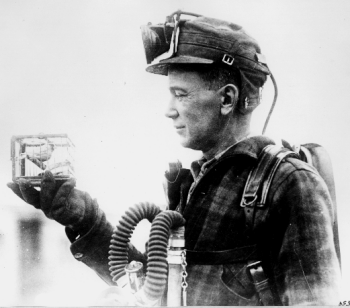Gases & Gas
Detection Methods
in the Coal Mines
|
|
Please Help Pets by Donating One Dollar
Gases found in the Coal Mines
The danger from explosions is ever present in coal mines.
Ignition of naturally occurring methane gas can be disastrous.
This gas is known in the pits as firedamp, a mixture of methane
gas and air.
Methane (CH4) is odorless, tasteless, colorless, and lighter
than air which means it is found near the roof of the mine
workings. The most dangerous mixture is between 5% and 15% when
an explosion is possible.
When miners know where gas is accumulating it is then possible to
dilute the gas by the addition of fresh air, thus lowering the
concentration of the gas.
methane (firedamp)
carbon monoxide (chokedamp) and
carbon dioxide
Canaries to Detect Gases in Coal Mines
Miners once used canaries to test the air quality in the mines.
Canaries are very sensitive to carbon monoxide. The canaries
would chirp and sing and make noise all day long. But, if
the carbon monoxide levels got too high, the canaries would
have trouble breathing, and maybe even die. When the canaries
were no longer singing, miners would know that the gas levels
were too high. They would leave the mine quickly to avoid
being caught in an explosion.
Fireman in the Coal Mines
Early coal mines were troubled by methane gas; the coal mine
management paid someone to disperse the gas by igniting it with a
flame. As you can imagine this was a very dangerous
occupation and these "firemen" literally risked their lives every
time they entered a gaseous area of the mine.
Fireman is widely known as an official of the mine in many
area's. Today they are called Fire Bosses.
The fireman walked down roads or tunnels with a candle and
ignited any accumulated gases he encountered. He held a long
stick with a candle at the end. Naturally this exploded any
methane present. His only protection was to wear clothing such as
wool, or leather, well damped, and his head protected by a hood
Very often the fireman was killed during the operation
of igniting the gas.
Flame Safety Lamp
Inventors worked on developing a flame lamp which could be safely
taken into a coal mine without igniting the methane gas present.
In 1815 Humphry Davy invented a safety lamp, George Stephenson,
working in a colliery near Newcastle, also produced a safety lamp
that year. Both men claimed that they were first to invent the
safety lamp.
Many variations of flame safety lamps were tried over many years,
but their accuracy in determining the amount of methane gas
present was questioned when it was discovered that air could be
circulating around the lamp this resulted in a false
percentage of methane being estimated.
The safety lamp burns oil. Inside the lamp is a wire gauze
cylinder of fine mesh which forms a cage around the flame. Heat
from the flame is dissipated and this prevents the flame from
propagating outside of the lamp.
The quantity of methane gas present in a particular part of the
mine was obtained by switching off cap lights etc. so the mine
was in darkness except for the light generated by the oil lamp,
holding the lamp up to the roof, lowering the wick, and looking
at the color, size and shape of the flame. If firedamp was
present a pale blue flame appeared around the central flame,
sometimes referred to as the "blue-cap".
The flame safety lamp also detects oxygen deficiency, known by
miners as blackdamp, a mixture of air and carbon dioxide (CO2)
which could be found near the floor, usually where the
ventilation is inadequate.
Picture Canary Bird with Coal Miner

See Also:
Canaries in Coal Mines
Tweety Bird, the Most
Famous Canary of all time
Canaries & Canaries as Pet Birds
Charming Stuffed Plush Birds
Cool Canary Calendars
|